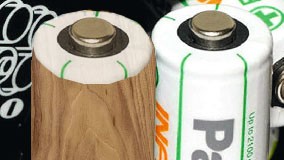3D-printed nanobatteries could solve power-hungry gadget woes
Smaller is always better (because you can fit more of them in, of course)
How nails regenerate finger tips could hold the answer to growing new limbs -- Unlike a salamander, mammals can't regrow whole limbs, but they can regenerate the tips of their fingers, if the nail remains intact.
Researchers from New York University have identified a cluster of nail-associated stem cells that's capable of regenerating lost tissue, at least in mice. The process requires that enough nail epithelium, the skin directly under the nail itself, remains intact. The stem cells are normally responsible for your ever-lasting nail growth, but when specially activated can fully restore mouse toe tips. They are capable of recruiting both nerve and mesenchymal cells, which can then build replacement bone, tendons and muscle. Since the genetic pathways that activate this regrowth are present in humans, it's thought the same process exists in man. In theory, this discovery could lead to the ability to regrow much larger proportions of lost limbs, artificially activating the hidden stem cells into their remarkable repair mode. That really would be a huge leap forward for medical science. [Nature]
Batteries made of wood could be the holy grail of high-capacity cells -- When you think of battery technology, trees don't exactly come to mind. Yes, we've probably all made a potato power a small bulb at one point in our lives, but now group of researchers are taking it one giant leap further.

By swapping lithium ions for sodium ions, and coating slices of wood 1,000 times thinner than paper in tin, large capacity batteries can be made cheaply and environmentally friendly. The beauty of using wood for both a structural and active part of the battery is that its fibrous nature makes it flexible. That means it can easily withstand the hundreds of expansions and contractions produced by repeated charging and discharging. In theory, wood nanobatteries could be perfect for storing large amounts of energy, cheaply and quickly, something the world badly needs if renewable energy, and electricity-powered transport is ever really going to take off. [Eurekalert]
Having a bad hair day? It's all copper's fault -- Have you ever wondered why, no matter how much you wash your hair, sometimes it just goes crazy? It seems there's a reason to the maddening phenomenon, and it's all to do with copper.
Given a single strand of hair can grow for up to three years before being replaced, scientists have discovered that the metal gradually builds up in human hair, as traces of it get washed into your mop like a sponge from your copper pipes. Once embedded in the hair, the copper acts as a catalyst helping form damaging reactive molecules in the sunlight, stripping hair of its protective outer cuticle sheath. That leaves the inner core of your hair exposed, leading to brittle, dull and split end-full hair. Apparently dying your hair magnifies the problem too. Now that copper has been identified as a hair-killer, researchers at the various pharmaceutical companies are looking at incorporating copper-stripping chemicals into our shampoos and hair dyes, so hopefully that'll help you get that mess back under control sooner rather than later. [The Telegraph]
Get daily insight, inspiration and deals in your inbox
Sign up for breaking news, reviews, opinion, top tech deals, and more.